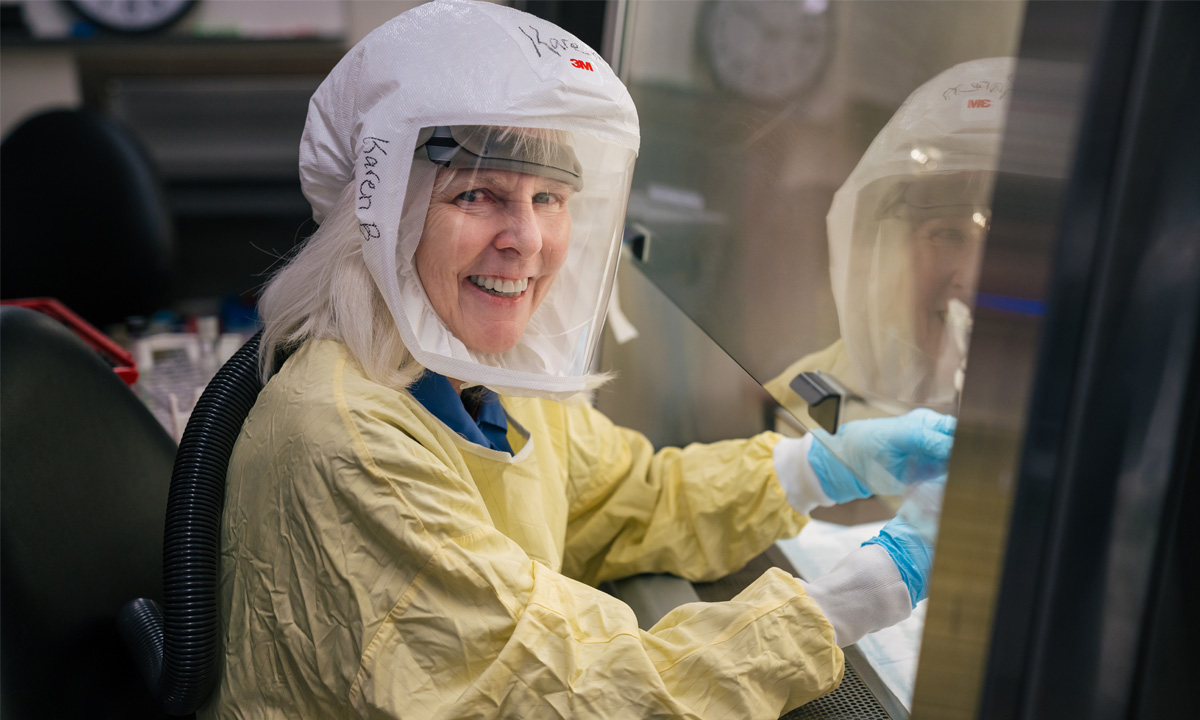
Karen Brisendine currently works as a technologist in ARUP’s Mycology Acid-Fast Bacilli (AFB) Lab, but she has worked in many departments at ARUP since she started with the company at its founding in 1984. Along the way, she has learned more about herself and discovered a passion for laboratory science.
In 1984, Karen Brisendine found out she would soon be moving from the University of Utah Hospital lab, where she had a specimen receiving job, to a new independent lab that would be separate from the U—ARUP Laboratories. At the time, she was worried that the newly formed company might fail, or that she would lose her job. Despite these fears, she chose to move over to the new lab and its Specimen Receiving team.
Forty years later, Brisendine is grateful she stayed with the company. She has built a meaningful career and made strong friendships at ARUP. She remembers the early years fondly and has enjoyed seeing ARUP’s progression from a small laboratory to Utah’s largest life sciences employer. Over the years, Brisendine has held many different roles at ARUP and advanced her education at Salt Lake Community College (SLCC), the University of Phoenix, and Weber State University.
In 1985, Brisendine transferred from Specimen Receiving to the Microbiology Lab as a technician. Although she later discovered a passion for microbiology, she initially changed departments for a greater sense of job security. “I was a little nervous it wouldn’t work, so that’s when I went into Microbiology,” she said. “I thought Microbiology was a lab they couldn’t do without.”
After many years in the lab, Brisendine began to explore other options for career growth. She started working in Accounting and Payroll. When asked why, she laughed and said, “To see if I could have coffee at my desk.” Brisendine made a lot of friends in Accounting but ultimately decided she would not be happy with her role there long term. “I’m just not a businessperson,” she said.
She then transferred to Client Services, where she learned more about the specialized lab testing beyond microbiology that ARUP offered. “I loved Client Services. I enjoyed talking to clients and learning about the different types of tests we offer,” she said. “When I’d call the labs, they’d explain the details of their testing in depth.”
After working in Client Services, Brisendine returned to Microbiology so that her work schedule could be adapted to fit her school schedule. She then started the medical laboratory technology (now medical laboratory science) program at SLCC to deepen her understanding of laboratory science and further her career.
On her return to Microbiology, Brisendine noted many changes since she had first worked in the lab. This time around, she understood more about the testing and how to prepare samples.
“When I started as a technician the first time, the role was pretty much just answering the phone and logging in samples,” she said. “The second time I was in Microbiology as technician, a lot of that computer work was automated. Instead, I was taught how to plate samples, which was really interesting.”
Brisendine explored a handful of new departments over the following years, including Specimen Sales, Molecular Genetics, and Immunology. She appreciated the opportunity to see how a reference lab operates from different angles.
In 2014, Brisendine received her bachelor’s degree at the University of Phoenix. While working toward the degree, she completed her biology labs and classes at Weber State University. She then returned to Microbiology for the third time—but this time, as a technologist. “Going back as a technologist, I was the one actually doing the testing. Microbiology itself has changed so much from the time I was there as a technician.” With each return to Microbiology, Brisendine’s responsibilities became more complex and fascinating.
ARUP has grown alongside Brisendine. Throughout her career journey, she has noticed the changes in ARUP’s workforce and testing procedures.
“In the beginning, I knew everybody,” Brisendine said. “Then, as ARUP grew, I’d see new people in the hall all the time.”
New departments have been created, too. Brisendine’s current laboratory, Mycology Acid-Fast Bacilli (AFB), used to be part of the Microbiology Lab. Now, Microbiology has split into subspeciality labs to adapt to testing demand and sample volume.
Brisendine is impressed by the advancements in testing methods throughout the last 40 years. One example is a test type she frequently performs, matrix-assisted laser desorption/ionization time-of-flight mass spectrometry (MALDI-TOF), which can identify bacteria more quickly than older methods. “Instead of being a 2- to 3-day process, it’s a 6-hour procedure. It’s cut down the turnaround time immensely,” Brisendine said.
She is also impressed with ARUP’s expanding campus and has brought former employees to Research Park to show them the newest building.
“My sister-in-law used to work at ARUP, and she lives in Maryland now. She came for a visit recently, and I was able to show her the brand new building,” Brisendine said. “She was absolutely floored at how much ARUP has changed.”
Brisendine loves learning, and that inspired her to explore many different positions at ARUP while pursuing her degrees and raising a family. Even now that she has settled into a single lab, she still feels like she learns something new every day.
















